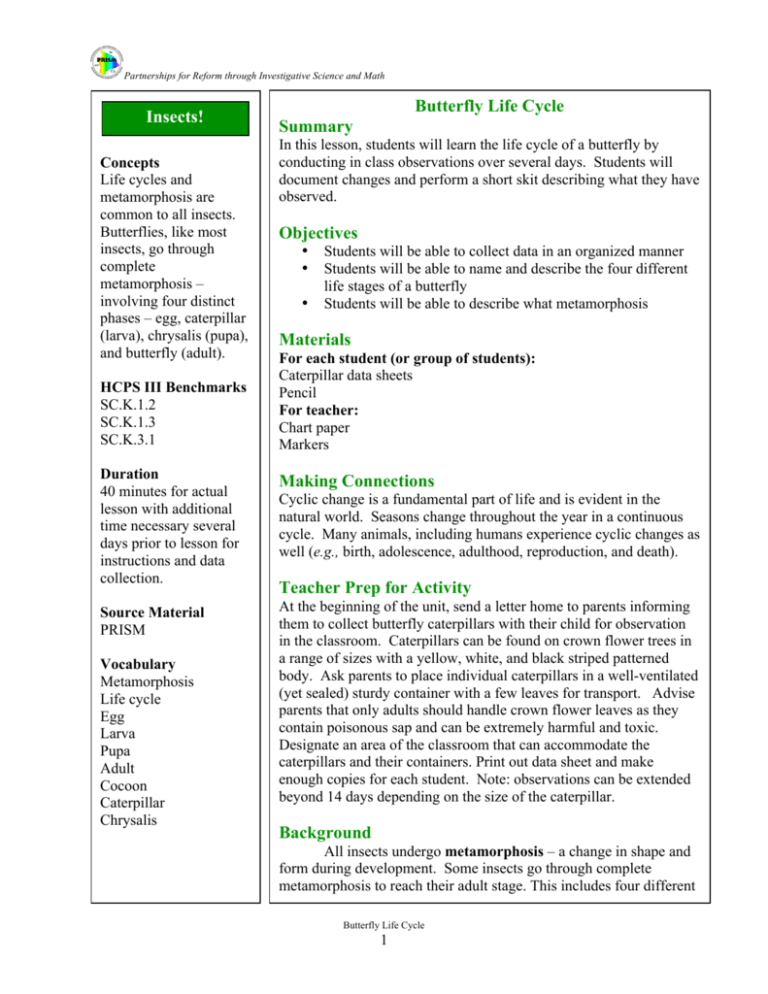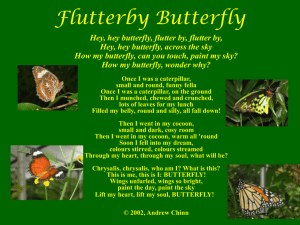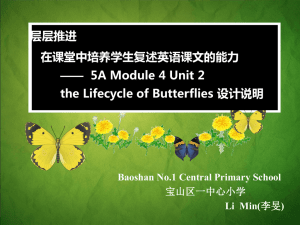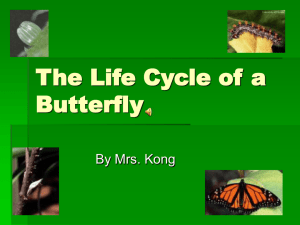Butterfly Life Cycle Summary Objectives Materials Making
advertisement

Partnerships for Reform through Investigative Science and Math Insects! Concepts Life cycles and metamorphosis are common to all insects. Butterflies, like most insects, go through complete metamorphosis – involving four distinct phases – egg, caterpillar (larva), chrysalis (pupa), and butterfly (adult). HCPS III Benchmarks SC.K.1.2 SC.K.1.3 SC.K.3.1 Butterfly Life Cycle Summary In this lesson, students will learn the life cycle of a butterfly by conducting in class observations over several days. Students will document changes and perform a short skit describing what they have observed. Objectives • • • Students will be able to collect data in an organized manner Students will be able to name and describe the four different life stages of a butterfly Students will be able to describe what metamorphosis Materials For each student (or group of students): Caterpillar data sheets Pencil For teacher: Chart paper Markers Duration 40 minutes for actual lesson with additional time necessary several days prior to lesson for instructions and data collection. Making Connections Source Material PRISM At the beginning of the unit, send a letter home to parents informing them to collect butterfly caterpillars with their child for observation in the classroom. Caterpillars can be found on crown flower trees in a range of sizes with a yellow, white, and black striped patterned body. Ask parents to place individual caterpillars in a well-ventilated (yet sealed) sturdy container with a few leaves for transport. Advise parents that only adults should handle crown flower leaves as they contain poisonous sap and can be extremely harmful and toxic. Designate an area of the classroom that can accommodate the caterpillars and their containers. Print out data sheet and make enough copies for each student. Note: observations can be extended beyond 14 days depending on the size of the caterpillar. Vocabulary Metamorphosis Life cycle Egg Larva Pupa Adult Cocoon Caterpillar Chrysalis Cyclic change is a fundamental part of life and is evident in the natural world. Seasons change throughout the year in a continuous cycle. Many animals, including humans experience cyclic changes as well (e.g., birth, adolescence, adulthood, reproduction, and death). Teacher Prep for Activity Background All insects undergo metamorphosis – a change in shape and form during development. Some insects go through complete metamorphosis to reach their adult stage. This includes four different Butterfly Life Cycle 1 Partnerships for Reform through Investigative Science and Math and distinct life stages: egg, larva, pupa, and adult. Larvae often look entirely different from their parents and spend most of their time eating. Once the larvae are big enough, they enter the pupa stage. During this time, the pupa is protected by a cocoon or chamber and its body undergoes transformation. When the pupa emerges from its cocoon it is an adult. Metamorphosis of a Monarch butterfly: The Monarch butterfly life cycle begins with a group of small white eggs laid on the underside of leaves. The eggs hatch three to six days after they are laid into larva called a caterpillar. Caterpillars are quite small at hatch and barely visible to the naked eye. Caterpillars spend most of their time eating and grow very fast. In two weeks caterpillars are full grown at approximately 2 inches long. During the two weeks the caterpillar will shed its skin around five times. Once fully grown, the caterpillar will leave its feeding area in search of a safe place to pupate. The caterpillar will hang upside down in a J-shape for one day then shed its skin for the last time to reveal a chrysalis. Within the chrysalis the caterpillar will undergo the transformation to become a butterfly. Over the course of approximately two week the chrysalis will change color from light green to dark brown. The chrysalis will crack open and a butterfly with crumpled wings will emerge. During this time the butterfly is incapable of flying. The butterfly will spend about an hour unfolding and drying its wings for flight. After the hour has passed the butterfly is ready to fly away. Similar to caterpillars, butterflies will spend most of their time feeding on flower nectar. Butterflies are ready to mate in about four to six days after emerging from their chrysalis. This concludes their life cycle. Vocabulary 1. Metamorphosis - change in shape and form during development. 2. Egg – first stage in life cycle from which larva hatches. 3. Larva – juvenile phase with different physical appearance from adult. 4. Pupa – intermediate phase between larva and adult. 5. Adult – mature phase of insect (phase that is able to reproduce). 6. Cocoon – protected chamber for pupa while body undergoes transformation. 7. Caterpillar – larva phase for butterflies. 8. Chrysalis – essentially pupa stage of development within which the caterpillar undergoes the transformation to become a butterfly. 9. Life cycle – cyclic pattern of life from birth to death. Procedure Note: most of the data collection will be conducted prior to the actual lesson 1. Once all caterpillars have been brought into class and settled, inform students that they will be monitoring their caterpillars over the next several days 2. As a class have students count and label the containers holding the caterpillars 3. Show students the monitoring data sheet. Go over the data sheet with the class – read each of the areas and show students how to fill in the data sheet 4. As a class, fill in the data sheet for that day. 5. Each student (or group of up to four students) is responsible for observing his or her caterpillars over the next several days. Note: If butterflies emerge during this time, allow students to release them (or do so as a class). 6. Do not allow students to handle crown flower leaves – they contain poisonous sap and can be extremely harmful and toxic. Only the teacher or adult should replace eaten leaves. Butterfly Life Cycle 2 Partnerships for Reform through Investigative Science and Math 7. On the day of the lesson, ask students to “What did you see during your observations?” 8. Emphasize the changes they observed (e.g., caterpillars got bigger/longer, caterpillars entered chrysalis). 9. Briefly introduce metamorphosis vocabulary – egg, larva (caterpillar), pupa, caterpillar, chrysalis (cocoon), and adult (butterfly). 10. Ask students “What do you think a life cycle is?” – break the words apart and ask individually is necessary (e.g., what is life? And what is a cycle?) 11. Provide a familiar example of a life cycle using humans as an example (i.e., baby to grandparent) 12. Introduce the concept of a life cycle in terms of a Monarch Butterfly – reiterate the changes that were observed. 13. Briefly introduce life cycle vocabulary. 14. Write vocabulary on chart paper in a manner that will allow you to draw arrows connecting the different stages in a circle. 15. Instruct students that they will now act out the life cycle of a Monarch butterfly. Note: this should be done in a spacious area – either indoors or outdoors. 16. With students standing, ask them to recall the first step in the life cycle – “Eggs.” 17. Tell students that they are to imagine that they are butterfly eggs by having them curl into a ball and huddle together to resemble a group of eggs. 18. Ask students “What comes next?” Then tell students they are ready to hatch into caterpillars. 19. Have students wiggle like their caterpillars and pretend to eat imaginary leaves. 20. After a few minutes of pretend eating, ask students “What comes next?” Tell the students they are now ready to become pupa. 21. Have them wiggle away to a safe spot and curl into a ball again. 22. Have students imagine they are pupa. Tell them that they are now safe to transform into a butterfly within their chrysalis. 23. Again, ask students “What comes next?” Then have students carefully flap their arms to resemble their wings while standing in place. 24. Tell them they must let their wings dry and unfold before they can fly away. 25. While continuously flapping, tell students their wings are now dry and they may fly away by walking around. 26. Tell them they must search for imaginary nectar to feed on. 27. Once again, ask students “What comes next?” After feeding tell students their ready to mate and lay eggs completing their life cycle. 28. Have students sit down and reconvene. 29. Recap key concepts from the lesson: 1. Metamorphosis is a change in body shape and form. 2. Butterflies have four different stages in their development – egg, caterpillar, chrysalis and adult. 3. Life cycles occur in circles that go round and round, over and over again. Assessments Completed data sheet Discussion and anecdotal records Class skit Butterfly Life Cycle 3 Partnerships for Reform through Investigative Science and Math Resources http://www.butterflybushes.com/monarch_metamorphosis.htm Math Connection Counting caterpillars incorporates math into this lesson. If time permits, caterpillars can be counted on a daily basis as a class. Also, it is expected that some caterpillars may die in the classroom so a subtraction exercise can be performed (e.g., yesterday we had 10 caterpillars, today we have 8, how many died?). Additionally, monitoring the length of the growing caterpillars will expose students to measurement and addition (e.g., caterpillars grew 2 cm over 5 days). Literature Connection Many books chronicle butterfly metamorphosis and life cycle, and can be read to supplement this lesson. ‘The Very Hungry Caterpillar’ by Eric Carle demonstrates the changes a caterpillar undergoes after eating some unorthodox food that may be familiar to students. ‘Waiting for Wings’ by Lois Ehlert also describes the entire life cycle of a butterfly beginning and ending with the egg. Additionally, a non-insect example of metamorphosis can be found in the book ‘Fish is Fish’ by Leo Lionni, which describes the transformation of a tadpole to a frog and its friendship with a minnow. Butterfly Life Cycle 4 Partnerships for Reform through Investigative Science and Math Sample letter home to parents: to be sent out prior to beginning the ‘Insects!’ unit Aloha Parents! As part of an ongoing science unit on insects, your student will be observing the life cycle of the monarch butterfly in class. The monarch butterfly life cycle consists of four distinct stages: egg, caterpillar, chrysalis and adult butterfly. Your child needs your help collecting caterpillars. Caterpillars can be found on crown flower plants (see left photo below) in a range of sizes (from barely visible with the naked eye to 2 inches long) with a yellow, white and black striped patterned body (see right photo below). Carefully place individual caterpillars in well ventilated, yet sealed, sturdy containers with a few leaves for transport. Please exercise extreme caution when handling crown flower leaves as they contain a poisonous sap that can be extremely toxic (students should not handle leaves). Also, we will begin observations on __________________, and would greatly appreciate if we could get caterpillars a few days prior. Mahalo! Teacher Crown flower plant (photo by Forest & Kim Starr) Monarch caterpillar (www.bbc.co.uk) Butterfly Life Cycle 5 Partnerships for Reform through Investigative Science and Math Caterpillar Data Sheet – Day 1 Name_________________________ Today is _________________________ What do you see? Draw your caterpillar. My caterpillar is this long: Butterfly Life Cycle 6 Partnerships for Reform through Investigative Science and Math Caterpillar Data Sheet – Day 2 Name_________________________ Today is _________________________ What do you see? Draw your caterpillar. My caterpillar is this long: Butterfly Life Cycle 7 Partnerships for Reform through Investigative Science and Math Caterpillar Data Sheet – Day 3 Name_________________________ Today is _________________________ What do you see? Draw your caterpillar. My caterpillar is this long: Butterfly Life Cycle 8 Partnerships for Reform through Investigative Science and Math Caterpillar Data Sheet – Day 4 Name_________________________ Today is _________________________ What do you see? Draw your caterpillar. My caterpillar is this long: Butterfly Life Cycle 9 Partnerships for Reform through Investigative Science and Math Caterpillar Data Sheet – Day 5 Name_________________________ Today is _________________________ What do you see? Draw your caterpillar. My caterpillar is this long: Butterfly Life Cycle 10 Partnerships for Reform through Investigative Science and Math Caterpillar Data Sheet – Day 6 Name_________________________ Today is _________________________ What do you see? Draw your caterpillar. My caterpillar is this long: Butterfly Life Cycle 11 Partnerships for Reform through Investigative Science and Math Caterpillar Data Sheet – Day 7 Name_________________________ Today is _________________________ What do you see? Draw your caterpillar. My caterpillar is this long: Butterfly Life Cycle 12 Partnerships for Reform through Investigative Science and Math Caterpillar Data Sheet – Day 8 Name_________________________ Today is _________________________ What do you see? Draw your caterpillar. My caterpillar is this long: Butterfly Life Cycle 13 Partnerships for Reform through Investigative Science and Math Caterpillar Data Sheet – Day 9 Name_________________________ Today is _________________________ What do you see? Draw your caterpillar. My caterpillar is this long: Butterfly Life Cycle 14 Partnerships for Reform through Investigative Science and Math Caterpillar Data Sheet – Day 10 Name_________________________ Today is _________________________ What do you see? Draw your caterpillar. My caterpillar is this long: Butterfly Life Cycle 15 Partnerships for Reform through Investigative Science and Math Caterpillar Data Sheet – Day 11 Name_________________________ Today is _________________________ What do you see? Draw your caterpillar. My caterpillar is this long: Butterfly Life Cycle 16 Partnerships for Reform through Investigative Science and Math Caterpillar Data Sheet – Day 12 Name_________________________ Today is _________________________ What do you see? Draw your caterpillar. My caterpillar is this long: Butterfly Life Cycle 17








